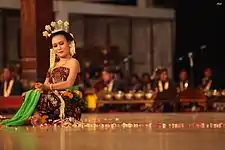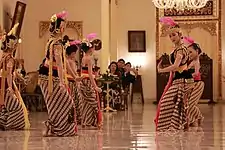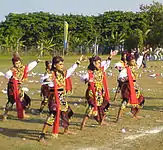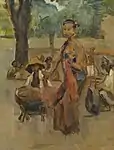Javanese dance
Javanese dance (Indonesian: Tarian Jawa; Javanese: ꧋ꦠꦫꦶꦗꦮ, romanized: Beksan Jawa) is the dances and art forms that were created and influenced by Javanese culture in Indonesia. Javanese dance movement is controlled, deliberate and refined. Javanese art often displays a finesse, and at the same time a serene composure which is elevated far above everything mundane.[1] Javanese dance is usually associated with courtly, refined and sophisticated culture of the Javanese kratons, such as the bedhaya and srimpi dance. However, in a wider sense, Javanese dance also includes the dances of Javanese commoners and villagers such as ronggeng, tayub, reog, and jaran kepang.

| Part of a series on the |
| Culture of Indonesia |
|---|
 |
| People |
| Languages |
| Mythology and Folklore |
| Cuisine |
| Literature |
| Music and Performing arts |
| Sport |
Javanese dance and its discipline has different styles and philosophy compared to other Indonesian dance traditions. Unlike vigorous and expressive Balinese dance or cheerful and slightly sensual Sundanese dance, Javanese dance are commonly involving slow movements and graceful poses. Javanese dance have somewhat a meditative quality and tends to be more self-reflective, introspective and more oriented toward self-understanding.[2] Javanese dance is usually associated with Wayang wong, and the palaces of Yogyakarta and Surakarta due to the nature of dance being a pusaka or sacred heirloom from ancestors of the palace rulers. These expressive dances are more than just dances, they are also used for moral education, emotional expression, and spreading of the Javanese culture.
Types of Javanese dance

Javanese dance reflects the stratified hierarchy of Javanese society, and roughly can be identified within two mainstream of traditions:
- Court dances (tari kraton)
- Commoner dances (tari rakyat)
Court dances (tari kraton)


The courtly Javanese palace dance is the type of dances that developed, nurtured and fostered by Javanese Kratons, mainly Yogyakarta Sultanate and Surakarta Sunanate, the patrons of Javanese Mataram culture. Javanese sultans are known as the patron and the creator of Javanese court dances.
Kraton dances employs sets of rules about certain dance movements, body and hand gestures that requires discipline to learn. Gamelan orchestra is the prerequisite for Javanese court dance performances as well as for other Javanese art forms such as Wayang performances. The serene elegance, slow pace and constrains of its movements gave Javanese dance a meditative traits. Javanese court dances were heavily influenced by Javanese Hindu-Buddhist legacy. As the result the costumes, jewelry and story, often reflects or based on Hindu epic tales of Ramayana and Mahabharata.
There are three basic types of courtly Javanese kraton dance:
- Beksan putra – These are the dances for men, which serve two purposes: a military close-order drill and highlighting martial skills. Dancers may learn beksan putra dances to familiarize themselves with the movements for narrative dances.
- Beksan putri – Putri is the Javanese word for female, and these dances include courtly dances designed for royal events with very precise movements and distinct staging with subtle layers of meaning. Such dances were often used for entertainment or courtship.
- Beksan wayang – These are narrative dances from epic poems, and usually are named after the characters in them, usually an alus-style hero and a gagah-style villain.
Bedhaya
Surakarta
- Bedhaya Ketawang
- Bedhaya Pangkur
- Bedhaya Duradasih
- Bedhaya Mangunkarya
- Bedhaya Sinom
- Bedhaya Endhol-endhol
- Bedhaya Gandrungmanis
- Bedhaya Kabor
- Bedhaya Tejanata
- Bedhaya Dempel
- Bedhaya La la
- Bedhaya To lu
- Bedhaya Alok
Yogyakarta
- Bedhaya Semang
- Bedhaya Tirta Hayuningrat
- Bedhaya Bedhah Madiun
- Bedhaya Partha Krama
- Bedhaya Sinom
Mangkunegara
- Bedhaya Anglir Mendung
- Bedhaya Bedhah Madiun
Pakualam
- Bedhaya Angron Akung
- etc.
- Some examples of Bedhaya dance
 The court of the Sultan of Yogyakarta, c. 1876. Performance of Bedhaya Sacred Dance accompanied by Javanese Gamelan Ensemble.
The court of the Sultan of Yogyakarta, c. 1876. Performance of Bedhaya Sacred Dance accompanied by Javanese Gamelan Ensemble._de_vader_van_de_bruid_Solo_TMnr_60020674.jpg.webp)
_to_the_Sultan_of_Yogyakarta_-_1884.tif.jpg.webp) The bedhaya dancers doing a sembah (tribute) to the Sultan of Yogyakarta in 1884.
The bedhaya dancers doing a sembah (tribute) to the Sultan of Yogyakarta in 1884. The Bedoyo dancers at the Susuhunan Palace Solo, Surakarta, between 1910 and 1930.
The Bedoyo dancers at the Susuhunan Palace Solo, Surakarta, between 1910 and 1930.
Srimpi
Surakarta
- Serimpi Ludira Madu
- Serimpi Sangupati
- Serimpi Gondokusuma
- Srimpi Renggowati
Yogyakarta
- Srimpi Pandelori
- Srimpi Jebeng
- Srimpi Muncar
- Srimpi Pramugari
Mangkunegara
- Serimpi Anglir Mendung
Pakualam
- Srimpi Renyep
- etc.
- Some examples of Srimpi dance
 The elegant dance of Srimpi.
The elegant dance of Srimpi. Srimpi Dhempel.
Srimpi Dhempel. "Serimpi" dancers of the Regent of Bandung (circa 1864)
"Serimpi" dancers of the Regent of Bandung (circa 1864) Srimpi Dancer in Yogyakarta.
Srimpi Dancer in Yogyakarta.
Golek
- Golek lambang sari
- Bondan
- Bambangan Cakil
- Topeng
- Banda Baya
- Wiropratomo
- Golek Menak
- etc.
Gambyong
- Gambyong Retno Kusumo
- Gambyong Pare Anom
- etc.
Beksan
- Beksan Lawung
- Beksan Anglingkusuma
- Beksan Jangerana
- Beksan Panji Ketawang
- Beksan Wireng
- Klana Raja
- Klana Alus
Wayang wong
- Wayang wong
- Some examples of Javanese court dances
 Beksan Puri Melati dance
Beksan Puri Melati dance Beksan Jebeng dance
Beksan Jebeng dance Gambyong Langenkusuma dance
Gambyong Langenkusuma dance Javanese-style dance at the 8th Malam Anugerah Sastra, Inna Garuda, Yogyakarta
Javanese-style dance at the 8th Malam Anugerah Sastra, Inna Garuda, Yogyakarta
Commoner dances (tari rakyat)
Topeng endel
Kethek ogleng
Lengger
Lengger lanang
Sintren
Angguk
Barongan
Tayub
Ronggeng
Kuda lumping
Topeng malang
Reog
Remo
It's the popular dances of the commoner. This is the type of Javanese dances that developed in villages or cities that located relatively quite far from Javanese kratons as the center of Javanese palace culture. Kawulo dances is lack in Javanese courtly dance discipline, constraints, and refinements. This type of dance relatively more open and adaptive to local preference as well as foreign influences.
Several dance forms function as courtship or social dance such as ronggeng, gandrung and tayub, while others are celebratory dances such as reog and kuda lumping. The movement of social dances, such as ronggeng and tayub are more vigorous and often erotic, closely related to Sundanese jaipongan. Because of the erotic nuances, those who perform this type of dance are sometimes perceived as intentionally being suggestive or even openly advertising sexual favors.
- Some examples of Javanese commoner dances

 Kuda Lumping also called "Jaran Kepang", is a traditional Javanese dance depicting a group of troops riding horses.
Kuda Lumping also called "Jaran Kepang", is a traditional Javanese dance depicting a group of troops riding horses.
 Remo dance
Remo dance
Gallery
- Some examples of Indonesian Traditional dance
- Beksan Nir Corona, a dance about COVID-19 prevention performed at Kraton Ngayogyakarta
 Ronggeng dance
Ronggeng dance Painting of Javanese dance
Painting of Javanese dance Painting of Javanese dance
Painting of Javanese dance
External links
- Gambyong Sukoretno dance at Mangkunegaran palace
- Golek Sulung Dayung dance at Yogyakarta palace
- Ramayana Javanese dance at Prambanan temple
References
- Lieberman, Fredric. "Relationships of Musical and Cultural Contrasts in Java and Bali". University of California Santa Cruz. Retrieved March 9, 2013.
- Kuncoro (23 August 2010). ""Harjuna Wijaya" Bedhaya Dance, Level of Human Perfection". Indonesia Culture.net. Archived from the original on 13 September 2010. Retrieved March 9, 2013.
- Brakel-Papenhuyzen, Clara (1995)Classical Javanese Dance Leiden KITLV Press ISBN 90-6718-053-X
- Soedarsono (1984) Wayang Wong Yogyakarta Gadjah Mada University Press




